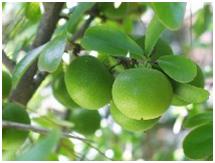 The Kei Apple or Umkokola (Dovyalis caffra or Aberia caffra) is a short and hardy tree species native to southern Africa. While useful as a fruit-bearing shrub it is more often applied as a natural fence due to the spiny nature of its branches. As the name implies, the fruit is similar to apples (but slightly smaller at about 60 mm, or the size of a plum). It’s most frequently compared to citrus fruits due to its extremely high Vitamin C content. It is traditionally eaten as a ‘famine fruit,’ or something people resort to when other crops have failed.
The Kei Apple or Umkokola (Dovyalis caffra or Aberia caffra) is a short and hardy tree species native to southern Africa. While useful as a fruit-bearing shrub it is more often applied as a natural fence due to the spiny nature of its branches. As the name implies, the fruit is similar to apples (but slightly smaller at about 60 mm, or the size of a plum). It’s most frequently compared to citrus fruits due to its extremely high Vitamin C content. It is traditionally eaten as a ‘famine fruit,’ or something people resort to when other crops have failed.
The fruit is also perfect for jams and jellies because the natural acidity balances the required sugar added for long-term preservation. Some, however, find the acidity to be wonderfully refreshing and eat the fruit plain. In addition to its Vitamin C and its high concentration of amino acids, recent research has shown Kei Apples to have a very significant antioxidant capacity—giving them a potential for widespread demand among health-conscious consumers. Traditionally, cultures in the Lowveld region have used the roots and thorns for their medicinal value in treating amenorrhea and chest pain, as well as rheumatism.
Its forgiving growing conditions make it ideal for regions not suited for water-intensive forms of agriculture. The Kei Apple performs best in dry, sandy soils and is capable of withstanding high levels of salinity. This makes the Umkokola potentially a potent ally in the continued fight against desertification by preventing erosion in areas with sandy soils. In addition, the Kei Apple can withstand saline conditions and is capable of tolerating ocean spray, making it a valuable sea-side resource. These qualities are vital to its long-term biological success and critical in potential adoption of more widespread cultivation. New varieties are currently being developed, with a focus on increasing natural sweetness in order to encourage raw consumption.
Currently, this tree is primarily used as a living fence and to provide privacy. In areas where grazing animals are responsible for consuming crops, these plants can be used as a protective barrier. Its strength and spines make it capable of warding off wild foraging pigs. Furthermore, its leaves can be used as feed for livestock such as cattle, goats and pigs and its flowers provide ample nectar, making it a favorite for bees and other pollinators. The many uses of this plant, combined with its sandy soil preference make it a potentially very valuable crop.
By Philip Newell, a research intern with the Nourishing the Planet project

Danielle Nierenberg, an expert on livestock and sustainability, currently serves as Project Director of State of World 2011 for the Worldwatch Institute, a Washington, DC-based environmental think tank. Her knowledge of factory farming and its global spread and sustainable agriculture has been cited widely in the New York Times Magazine, the International Herald Tribune, the Washington Post, and
other publications.
Danielle worked for two years as a Peace Corps volunteer in the Dominican Republic. She is currently traveling across Africa looking at innovations that are working to alleviate hunger and poverty and blogging everyday at Worldwatch Institute’s Nourishing the Planet. She has a regular column with the Mail & Guardian, the Kansas City Star, and the Huffington Post and her writing was been featured in newspapers across Africa including the Cape Town Argus, the Zambia Daily Mail, Coast Week (Kenya), and other African publications. She holds an M.S. in agriculture, food, and environment from Tufts University and a B.A. in environmental policy from Monmouth College.








